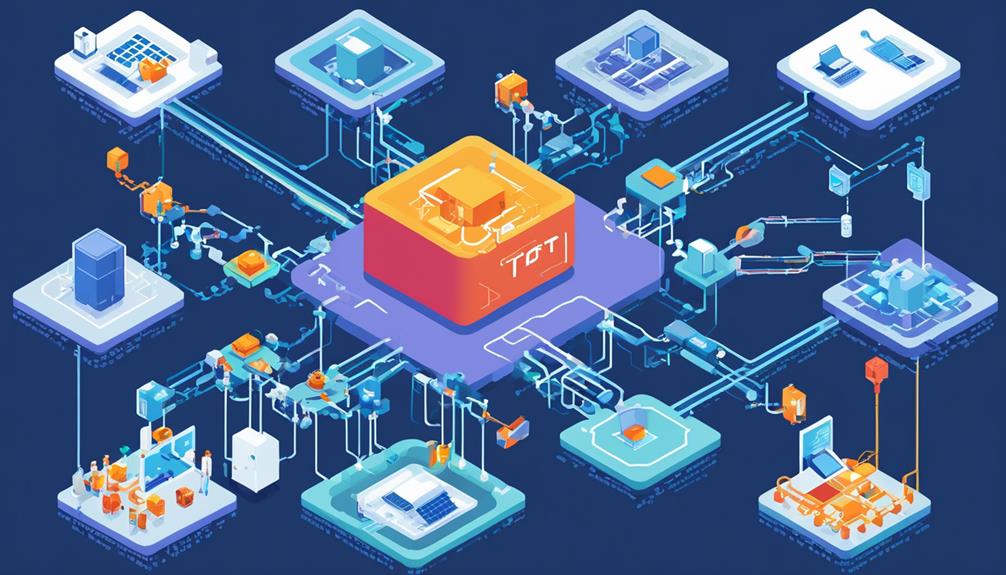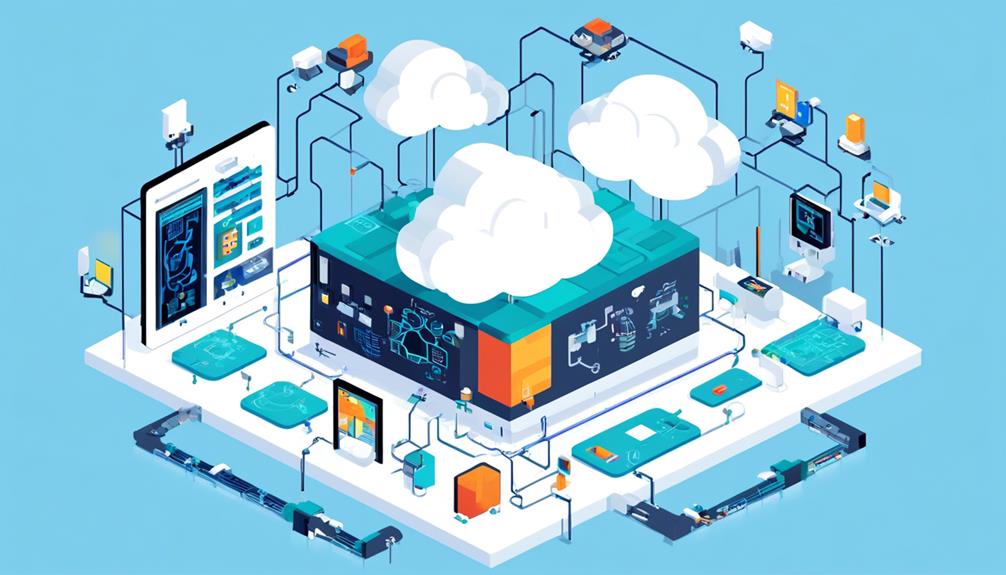Gateway hardware plays a critical role in the smooth operation of IoT networks. These devices serve as the bridge between IoT devices and the cloud, ensuring seamless connectivity and secure communication. Gateway hardware not only manages device connectivity but also preprocesses data, routing traffic, and enhancing overall network performance.
With integrated security functions, gateway hardware mitigates the risks of cybersecurity threats in IoT environments. In this discussion, we will explore the importance of gateway hardware, its functions, and the benefits it brings to IoT networks.
Furthermore, we will delve into the role of gateway hardware in managing data flow, pre-processing data at the edge, and enhancing security. Lastly, we will provide insights into how to choose the right gateway hardware solution for specific IoT requirements.
Key Takeaways
- Gateway hardware is essential for seamless connectivity and secure communication in IoT networks.
- Gateway hardware acts as the bridge between IoT devices and the cloud, managing device connectivity and preprocessing data.
- Gateways support various protocols, provide integrated security functions, and enable in-depth data analytics.
- Proper placement of gateways is crucial for optimal connectivity, data transfer, and overall network performance.
Importance of Gateway Hardware

The importance of gateway hardware in IoT networks cannot be overstated. IoT gateways act as a crucial link between IoT devices and the cloud, enabling seamless connectivity and efficient data management. These gateways play a pivotal role in ensuring reliable and secure communication between devices, making them an essential component of any IoT ecosystem.
One of the key functions of IoT gateways is to pre-process data locally at the edge. By performing data analysis and filtering at the edge, gateways reduce the volume of data that needs to be sent to the cloud. This not only improves response times but also helps in optimizing network transmission costs. With the exponential growth of IoT devices and the massive amounts of data generated, edge computing provided by gateways becomes increasingly significant.
Moreover, IoT gateways provide integrated security functions, safeguarding devices and sensitive data against cyber threats. With the rising concerns around data privacy and security breaches, the ability of gateways to enforce authentication and encryption protocols ensures the integrity and confidentiality of IoT networks.
Thales offers a range of pre-certified and customizable IoT gateways that simplify the design and development process, accelerating the prototype to production timelines. These gateways support various use cases, such as asset tracking, equipment monitoring, vehicle system monitoring, control for e-bikes, and condition monitoring for industrial equipment. The flexibility and scalability of Thales' gateway solutions make them ideal for diverse IoT environments.
Function of Gateway Hardware
In order to fully understand the function of gateway hardware in IoT networks, it is important to recognize the pivotal role these devices play as the central hub connecting IoT devices to the cloud. IoT gateway hardware serves as a connection point between the cloud and IoT devices, acting as a bridge for data transmission. These gateways act as network routers, handling inbound and outbound traffic between IoT devices and the cloud. They are responsible for sending IoT data to the cloud, enabling seamless communication and data processing.
One of the key functions of IoT gateways is their ability to preprocess data locally at the edge. By performing data processing at the edge, gateways reduce the volume of data that needs to be sent to the cloud. This not only improves response times but also reduces network transmission costs. Additionally, IoT gateways can support various protocols for different IoT devices, ensuring compatibility and smooth operation.
Security is another crucial aspect of gateway hardware. IoT gateways provide integrated security functions to protect devices and sensitive data against cyber threats. These security measures can include authenticated access, security assessments, and up-to-date software to ensure the highest level of protection.
Thales, a leading provider of IoT solutions, offers plug-and-play IoT gateways that simplify the design and development process. These gateways accelerate the timeline from prototype to production, providing customized solutions for connecting small to mid-sized IoT solutions.
Role in IoT Device Connectivity

IoT gateways play a crucial role in providing connectivity options for IoT devices. They act as the bridge between devices and the cloud, enabling data transmission and communication.
When selecting a gateway, important criteria to consider include compatibility with different IoT protocols, security features, and scalability.
Additionally, the placement of gateways is of utmost importance to ensure optimal connectivity and data transfer between devices and the cloud.
Connectivity Options for Iot
Connectivity options play a crucial role in ensuring seamless and secure communication for IoT devices. IoT gateways act as a connection point between the cloud and IoT devices, handling inbound and outbound traffic, managing device firmware updates, and supporting various protocols for different IoT devices. These gateways enable the management and processing of a large volume of data generated by connected devices, reducing data volume through filtering and preprocessing. They also provide integrated security features to ensure secure connectivity and protect sensitive data. In addition to basic data analytics, IoT gateways enable in-depth data analytics by aggregating sensor data and routing data to the appropriate destinations. They serve as a central hub for device management, software updates, and fleet management. With their ability to handle a significant amount of data in real-time, IoT gateways are essential components in the IoT ecosystem.
| Connectivity Options | Description |
|---|---|
| Cellular Gateways | Industrial-grade connectivity solutions pre-configured with cloud-based IoT edge management. Suitable for a broad range of M2M and IoT applications. |
| Cellular Routers | Reliable and versatile connectivity options with support for LTE, WAN, LAN, Wi-Fi, and serial connectivity. Suitable for industrial applications. |
| M110 Modems | Reliable and secure connectivity suitable for various IoT deployment scenarios. Enables seamless data transmission and enhances IoT communication. |
Gateway Selection Criteria
Gateway selection criteria play a crucial role in determining the optimal gateway for IoT device connectivity. When choosing gateway hardware for IoT networks, several factors should be considered:
- Compatibility: The gateway should support the required communication protocols and standards for seamless integration with IoT devices.
- Scalability: The gateway should be able to handle a growing number of connected devices and data traffic without performance degradation.
- Security: Robust security features such as authentication, encryption, and secure boot are essential to protect IoT networks from cyber threats.
- Connectivity options: The gateway should offer a variety of connectivity options, including wired and wireless, to accommodate different network environments.
- Firmware management: The gateway should support easy firmware updates and management to ensure device functionality and security.
Considering these criteria will help in selecting the right gateway hardware for IoT networks, ensuring reliable and secure internet connectivity for IoT devices while effectively managing device firmware.
Importance of Gateway Placement
Proper placement of the gateway within an IoT network infrastructure is crucial for optimizing data transmission and ensuring seamless connectivity between IoT devices and the cloud. The strategic placement of IoT gateways plays a significant role in reducing latency and enhancing the reliability of IoT device connections.
By placing gateways strategically, data can be preprocessed at the edge, reducing the volume of data that needs to be sent to the cloud for processing. This ensures more efficient use of internet bandwidth and minimizes network congestion.
Gateway placement also impacts the security of IoT networks, as it ensures that devices are shielded from potential cyber threats and vulnerabilities.
Furthermore, gateway placement directly influences the overall performance and effectiveness of IoT networks, affecting the scalability and flexibility of the network infrastructure.
Managing Data Flow in IoT Networks

Efficient management of data flow is crucial in IoT networks to ensure seamless communication between devices and the cloud. Gateways play a vital role in managing this data flow by serving as a connection point between IoT devices and the cloud.
Here are some key aspects of managing data flow in IoT networks:
- Data acquisition layer: Gateways act as an interface between devices and sensors in the field and the cloud. They collect data from various IoT devices and sensors, aggregating and preprocessing it before sending it to the cloud for further analysis.
- Preprocessing at the edge: Gateways are designed to perform data preprocessing locally at the edge. This reduces the volume of data that needs to be sent to the cloud, minimizing bandwidth consumption and storage costs. It also enables real-time processing and decision-making capabilities, improving overall system responsiveness.
- Traffic routing and management: Gateways act as network routers, handling inbound and outbound traffic within the IoT network. They ensure that data is efficiently routed between devices and the cloud, optimizing network performance and reducing latency.
- Security functions: Gateways provide integrated security functions to protect the IoT network. They authenticate devices and sensors, encrypt data transmissions, and implement access control mechanisms. Regular security assessments, keeping gateway software updated, and reviewing gateway access are essential for maintaining a secure IoT network.
- Monitoring and management: Gateways enable administrators to monitor and manage the IoT network effectively. They provide visibility into the status and performance of connected devices, allowing administrators to troubleshoot issues, perform firmware updates, and ensure the overall health of the network.
Benefits of Using Gateway Hardware
Gateway hardware offers cost-effective connectivity options by reducing network transmission costs and improving response times.
Additionally, it enhances data security through integrated security functions, protecting devices and sensitive data against cyber threats.
Furthermore, gateway hardware streamlines data management by allowing for local data preprocessing at the edge, reducing the volume of data sent to the cloud and facilitating efficient firmware updates.
Cost-Effective Connectivity Options
With its cost-effective features, gateway hardware provides efficient connectivity options for a wide range of M2M and IoT applications. These cost-effective connectivity options offer several benefits for organizations implementing IoT networks:
- Cost-effective cellular gateways: These gateways provide connectivity for M2M and IoT applications, reducing overall costs.
- Rugged and industrial cellular routers: These routers offer reliable and versatile connectivity options for industrial applications, minimizing expenses.
- M110 modems: These modems provide reliable and secure connectivity across various IoT deployment scenarios, offering cost-effective solutions.
- SGX 5150 IoT device gateway: This gateway enhances IoT connectivity and communication, integrating IoT devices and systems in a cost-effective manner.
- Reduced network transmission costs: IoT gateways act as central hubs, reducing data volume forwarded to the cloud, improving response times, and minimizing network transmission costs.
Enhanced Data Security
Enhanced data security is a paramount benefit of utilizing gateway hardware in IoT networks. Gateways provide integrated security functions to protect devices and sensitive data against cyber threats.
IoT gateways act as a central point to connect IoT devices and offer a wide range of security features. One of the key advantages is that gateways enable authenticated and secure connectivity, ensuring reliable and secure data transmission.
They also offer a separate network for IoT gateways and devices, enhancing security by reducing sensitive information leakage and minimizing data volume sent to the cloud. By aggregating data at the gateway level, gateways improve response times and network transmission costs.
Additionally, integrated security functionality in gateways helps filter and minimize data produced by IoT devices, improving resiliency and protecting devices and sensitive data against cyber threats.
To further enhance data security, it is essential to regularly update gateway software, perform security assessments, and include gateways in security audits.
Streamlined Data Management
Utilizing gateway hardware in IoT networks not only enhances data security but also streamlines data management, improving efficiency and reducing processing time.
IoT gateways act as a centralized hub that allows IoT devices to send data to the cloud, simplifying data handling and analysis. These gateways sit between IoT devices and the internet, collecting and forwarding data from multiple devices to the cloud.
By pre-processing data locally at the edge, gateways reduce the volume of data forwarded to the cloud, optimizing network transmission costs and bandwidth. Additionally, gateways offer integrated security functions, protecting data and devices against cyber threats.
Furthermore, these gateways facilitate seamless connectivity and communication between different protocols and devices, enhancing overall data management capabilities.
With streamlined data management provided by IoT gateways, response times are improved, costs are reduced, and data is processed to meet specific needs efficiently.
Gateway Hardware for Micromobility
Gateway hardware for micromobility is essential for providing industrial-grade connectivity and managing IoT devices in this specific deployment scenario. In the context of micromobility, which includes electric scooters, bikes, and other small vehicles, IoT gateways play a crucial role in enabling seamless communication between edge devices and the cloud. These gateways serve as a connection point between the Internet of Things (IoT) devices and the cloud, handling inbound and outbound traffic, managing firmware updates, and preprocessing data locally at the edge.
To emphasize the importance of gateway hardware for micromobility, consider the following table:
| Gateway Hardware | Features and Benefits |
|---|---|
| Cellular Gateways | Provides industrial-grade connectivity and pre-configured IoT solutions |
| Cellular Routers | Offers versatile and reliable connectivity options |
| M110 Modems | Enables reliable and secure connectivity for IoT applications |
| SGX 5150 and SGX 5150 MD | Next-generation IoT device gateways suitable for various deployment scenarios |
| IoT Gateways | Acts as a connection point between IoT devices and the cloud |
In micromobility scenarios, where edge devices such as electric scooters and bikes are widely used, gateway hardware ensures reliable and secure connectivity for these IoT devices. Cellular gateways, routers, and modems provide the necessary connectivity options, while IoT gateways act as the central hub for managing and processing data from these devices.
Gateway Hardware for Industrial Monitoring

In the realm of industrial monitoring, the role of gateway hardware becomes pivotal in facilitating seamless connectivity and efficient management of IoT devices. IoT gateways serve as a connection point between the cloud and IoT devices, providing a central hub for IoT connectivity and device management. They support various connectivity technologies, such as cellular, Wi-Fi, LAN, and serial, making them suitable for a wide array of industrial applications.
One key aspect of IoT gateways in industrial monitoring is their role in edge computing. These gateways preprocess data locally at the edge, reducing the volume of data sent to the cloud. This improves response times and network transmission costs, enabling real-time monitoring and analysis of industrial processes.
Security is another critical aspect of IoT gateways for industrial monitoring. These gateways provide integrated security functions to protect devices and sensitive data against cyber threats. Check Point, for example, offers IoT security solutions specifically designed for gateways and vulnerable IoT devices. This ensures that the industrial monitoring system remains secure and protected from potential attacks.
Thales offers a range of plug-and-play IoT gateways that are ideal for industrial monitoring. Their Cinterion Smart Gateways, Efficient Gateways, and Device Gateway accelerate the prototype to production timelines and simplify the design and development process. These gateways provide reliable connectivity options and robust security features, making them suitable for industrial monitoring applications where devices operate in challenging environments.
Gateway Hardware for Emissions Monitoring
When it comes to emissions monitoring, sensor compatibility and data transmission efficiency are critical factors to consider in gateway hardware selection.
The ability of the gateway to support and integrate with a wide range of sensors ensures accurate and comprehensive monitoring of emissions data.
Additionally, efficient data transmission capabilities enable real-time monitoring and analysis, facilitating timely decision-making and effective emissions management strategies.
Selecting gateway hardware that excels in sensor compatibility and data transmission efficiency is key to ensuring reliable and accurate emissions monitoring in IoT networks.
Sensor Compatibility
Sensor compatibility is a critical factor to consider when selecting an IoT gateway for emissions monitoring. The gateway hardware must support the specific sensors used for emissions monitoring to ensure seamless integration and accurate data collection.
To ensure compatibility, consider the following:
- Look for gateway solutions that offer a wide range of sensor connectivity options, such as analog, digital, or specialized emissions sensors.
- Verify compatibility with industry-standard communication protocols, such as Modbus, CAN, or OPC UA, for smooth integration with emissions monitoring sensors.
- Ensure that the selected gateway hardware can handle the required data transmission rates and formats of the emissions monitoring sensors.
- Consider the scalability of the gateway hardware to accommodate future sensor additions or changes in the emissions monitoring system.
- Evaluate the compatibility of the gateway hardware with the existing IoT devices and infrastructure in the Internet of Things network.
Data Transmission Efficiency
To ensure the efficient transmission of data in emissions monitoring applications, it is essential to consider the data transmission efficiency of the gateway hardware used. IoT gateways play a crucial role in optimizing the flow of information between IoT devices and the cloud. Efficient gateways can preprocess data locally at the edge, reducing the volume of data sent to the cloud. They can also offer failover clustering and local data caching, improving data transmission reliability and efficiency. In addition, secure and reliable connectivity options in gateway hardware enhance the efficiency of data transmission for emissions monitoring. Integrating security functionality into IoT gateways ensures the efficiency and protection of data transmission in emissions monitoring applications. The choice of protocols and connectivity options plays a significant role in achieving data transmission efficiency.
| Benefits | Considerations |
|---|---|
| Preprocess data at the edge | Choose gateways with failover clustering |
| Reduce data volume sent to the cloud | Opt for gateways with local data caching |
| Improve data transmission reliability | Ensure secure and reliable connectivity options |
| Integrate security functionality | Select gateways with efficient protocols |
Pre-Processing Data at the Edge

Pre-processing data at the edge is a crucial step in optimizing IoT networks, enabling local analysis and filtering before transmitting data to the cloud or a central server. This approach offers several benefits that enhance the overall efficiency and security of IoT systems.
Some key advantages of pre-processing data at the edge include:
- Bandwidth optimization: By performing data analysis and filtering at the edge, IoT devices can reduce the amount of data sent over the network. This minimizes bandwidth consumption and lowers storage costs, as only relevant data is transmitted to the cloud or central server.
- Enhanced security: Pre-processing data at the edge helps mitigate security risks. By filtering and analyzing data locally, sensitive information can be protected from potential leaks and unauthorized access. It also allows for real-time threat detection and response, enhancing the overall security of IoT networks.
- IoT gateway integration: IoT gateways play a critical role in enabling pre-processing of data at the edge. These gateway devices provide the necessary hardware and software capabilities to perform local data caching and failover clustering. They act as intermediaries between IoT devices and the cloud, facilitating efficient data processing and transmission.
- Improved response times: Edge computing, including pre-processing data at the edge, significantly reduces response times by minimizing the volume of data forwarded to the cloud. This enables faster decision-making and real-time analysis, particularly in time-sensitive applications such as industrial automation or autonomous vehicles.
- Cost optimization: By reducing network transmission costs and storage requirements, pre-processing data at the edge can lead to significant cost savings in IoT deployments. It allows organizations to make more efficient use of their resources and scale their IoT networks more effectively.
Enhancing Security With Gateway Hardware
Gateway hardware plays a critical role in enhancing the security of IoT networks by providing integrated security functions and serving as a secure connection point between IoT devices and the cloud. These gateways not only enable the seamless flow of data between devices and the cloud but also ensure the protection of sensitive information and the prevention of unauthorized access.
To better understand the security enhancements provided by gateway hardware, let's take a look at the following table:
| Security Function | Description |
|---|---|
| Authentication | Gateways can authenticate IoT devices, ensuring that only authorized devices can connect. |
| Encrypted Communication | Gateway hardware can establish secure connections using encryption protocols like SSL/TLS. |
| Intrusion Detection | Gateways can detect and prevent unauthorized access attempts, alerting administrators promptly. |
By incorporating these security functions, gateway hardware can mitigate the risks associated with IoT networks. It protects against cyber threats such as unauthorized access, data breaches, and tampering of sensitive information. Additionally, gateways enable the implementation of security measures at the network level, ensuring that all IoT devices connected to the gateway adhere to the defined security protocols.
Furthermore, gateway hardware facilitates secure internet connectivity for various use cases. Whether it's asset tracking, equipment monitoring, or specialized scenarios like micromobility/light electric vehicles and industrial equipment monitoring, gateways provide a secure and reliable connection between devices and the cloud.
Choosing the Right Gateway Hardware Solution

When selecting the appropriate gateway hardware solution for IoT networks, it is crucial to consider various factors such as:
- Industrial-grade cellular gateways: These gateways are pre-configured with cloud-based IoT edge solutions for device management. They provide reliable connectivity and are designed to withstand harsh industrial environments. They are suitable for large-scale deployments in industries such as manufacturing, transportation, and agriculture.
- Rugged cellular routers: These routers are specifically designed for industrial applications and support various connectivity options such as Ethernet, Wi-Fi, and cellular. They offer robust security features and are capable of handling high data throughput. Rugged cellular routers are ideal for remote monitoring and control in industries like oil and gas, utilities, and mining.
- Next-generation IoT device gateways: These gateways, such as the SGX 5150, are highly versatile, secure, and suitable for specific industry certifications. They offer advanced features like edge computing, protocol translation, and data filtering. Next-generation IoT device gateways are suitable for applications requiring real-time analytics, AI, and machine learning.
- Thales IoT gateways: Thales offers a range of IoT gateways, including plug-and-play solutions and pre-certified gateways that simplify design and development processes. These gateways provide secure connectivity, seamless integration with Thales IoT ecosystem, and support for various communication protocols. They are suitable for industries that require a high level of security and compliance.
Frequently Asked Questions
What Is a Gateway Device in Iot?
A gateway device in IoT plays a crucial role in connecting and managing various IoT devices within a network. It serves as a bridge between the devices and the cloud, enabling data aggregation and analysis.
Key features of an IoT gateway device include support for multiple communication protocols and integration of edge computing capabilities.
Security considerations are also essential, as gateway devices handle sensitive data.
What Hardware Is Needed for Iot?
Essential components for IoT hardware include:
- IoT sensors: These sensors are diverse and can include temperature, humidity, motion, and pressure sensors, among others.
- Connectivity options: IoT devices can connect through cellular, Wi-Fi, and Bluetooth options.
- Power management: Efficient power management is crucial for the optimal operation of IoT devices.
- Security considerations: Encryption, authentication, and access control are important aspects of ensuring the security of IoT networks.
- Real-time data processing: Timely analysis and decision-making are enabled through real-time data processing.
Is a Router an Iot Gateway?
A router can serve as an IoT gateway, providing advantages such as network connectivity, routing capabilities, and the ability to preprocess data locally.
However, routers may have limitations in terms of processing power, security features, and scalability.
Alternatives to using a router as an IoT gateway include dedicated gateway devices that offer more advanced features and performance.
When selecting an IoT gateway device, key features to consider include data processing capabilities, communication protocols, security measures, and scalability.
Common protocols used for communication between IoT devices and gateways include MQTT, CoAP, and HTTP.
Security considerations for IoT gateways and routers include authentication, software updates, and regular security audits.
How Do I Make an Iot Gateway?
To make an IoT gateway, you need to understand the essential components, choose the right hardware, and follow specific steps.
The components typically include a microcontroller or microprocessor, wireless communication modules, sensors, and power management.
Choosing the appropriate hardware depends on factors like connectivity options, processing power, and power consumption.
Building an IoT gateway involves steps such as designing the hardware and software architecture, setting up the network, implementing security measures, and integrating multiple protocols.
Common challenges include interoperability, scalability, and data management.
Best practices for securing an IoT gateway include using authentication, encryption, and regular software updates.

